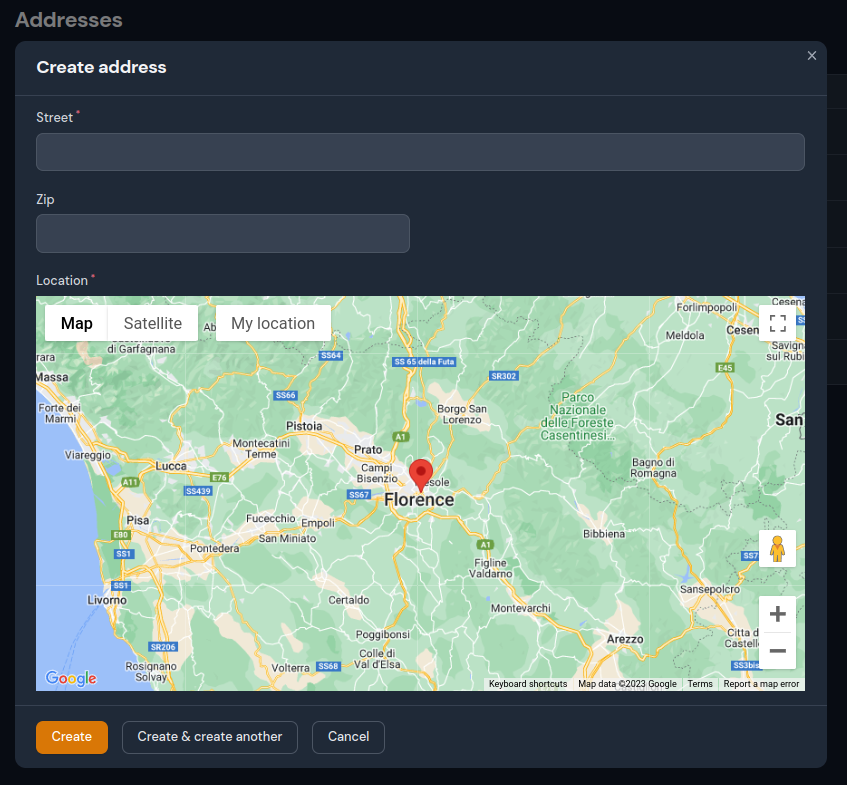- Installation
- Setting your Google Maps API Key
- Preparing the models
- Usage
- Changelog
- Contributing
- Security Vulnerabilities
- Credits
- License

This package provides just a simplified location picker field within Filament using Google Maps based on the excellent work of Hugh Messenger.
#Installation
You can install the package into a Laravel app that uses Filament via composer::
composer require arbermustafa/filament-locationpickr-field:"^2.0.0"Filament V2 - if you are using Filament v2.x, you can use 1.x branch.
You can publish the config file with:
php artisan vendor:publish --tag=filament-locationpickr-field-configThe config file contains default global customization options for map rendering, like: api key, default location, etc.
Optionally, you can publish the view using:
php artisan vendor:publish --tag=filament-locationpickr-field-views#Setting your Google Maps API Key
All use of the Google Maps API requires an API key. If you don't have one, refer to Google's documentation.
Once you have a key, either add it to your .env file as:
GMAP_API=your_map_api_key_here... or publish and edit the filament-locationpickr-field.php config file.
#Preparing the models
Add a location column to any model migration schema used for map data
... Schema::table('table_name', function (Blueprint $table) { $table->json('location')->nullable();}); ...and add the column to the model fillable array
... protected $fillable = [ ... 'location',];If you have separate columns for lat and lng you can use a computed property on any model being used for map data and use a mutator which converts between separate lat and lng fields on your table, and a Google Point style array of 'lat' and 'lng' keys.
... protected $appends = [ ... 'location',]; ... public function location(): Attribute{ return Attribute::make( get: fn ($value, $attributes) => json_encode([ 'lat' => (float) $attributes['lat'], 'lng' => (float) $attributes['lng'], ]), set: fn ($value) => [ 'lat' => $value['lat'], 'lng' => $value['lng'], ], );} ...#Usage
#Form field
The form field can be used with no options, by simply adding this to your Filament Form schema:
use ArberMustafa\FilamentLocationPickrField\Forms\Components\LocationPickr;... ->schema([ ... LocationPickr::make('location'), .... ]);...The name used in the make() function must be the one you set up as your model's column/computed location property.
#Full options
The full set of options is as follows. All option methods support closures, as well as direct values.
use ArberMustafa\FilamentLocationPickrField\Forms\Components\LocationPickr;... ->schema([ ... LocationPickr::make('location') ->mapControls([ 'mapTypeControl' => true, 'scaleControl' => true, 'streetViewControl' => true, 'rotateControl' => true, 'fullscreenControl' => true, 'zoomControl' => false, ]) ->defaultZoom(5) ->draggable() ->clickable() ->height('40vh') ->defaultLocation([41.32836109345274, 19.818383186960773]) ->myLocationButtonLabel('My location'), .... ]);...#Infolist entry
The infolist entry can be used with no options, by simply adding this to your Filament Infolist schema:
use ArberMustafa\FilamentLocationPickrField\Infolists\Components\LocationPickr;... ->schema([ ... LocationPickr::make('location'), .... ]);...The name used in the make() function must be the one you set up as your model's column/computed location property. The components accepts options like defaultZoom, defaultLocation and height.
#Example usage in simple resource

#Changelog
Please see CHANGELOG for more information on what has changed recently.
#Contributing
If you want to contribute to this package, you may want to test it in a real Filament project:
- Fork this repository to your Github account.
- Create a Filament app locally.
- Clone your fork in your Filament app root directoy.
- In the
/filament-locationpickr-fielddirectory, create a branch for your fix/improvement, e.g.fix/pickr-field.
Install the package in your app's composer.json:
"require": { "arbermustafa/filament-locationpickr-field": "dev-fix/pickr-field as dev-main",},"repositories": [ { "type": "path", "url": "./filament-locationpickr-field" }]Now run composer update.
#Security Vulnerabilities
Please review our security policy on how to report security vulnerabilities.
#Credits
#License
The MIT License (MIT). Please see License File for more information.